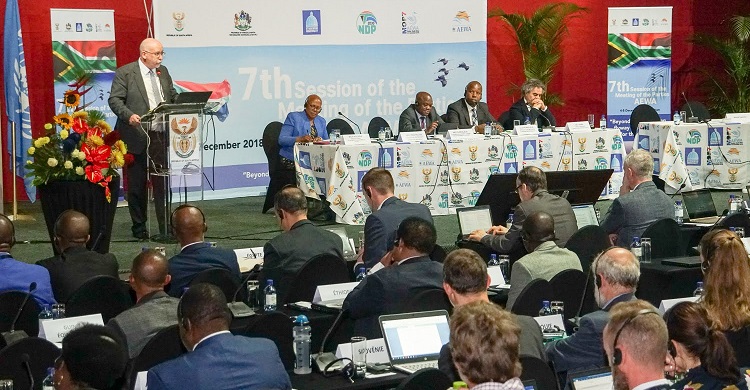Looking back at AEWA MOP7 in Durban, South Africa

The Seventh Meeting of the Parties (MOP7) to the Agreement on the Conservation of African-Eurasian Migratory Waterbirds (AEWA) took place from 4-8 December in Durban, Kwa-Zulu Natal, South Africa © Aydin Bahramlouian
Bonn, 3 April 2019 - The Seventh Meeting of the Parties (MOP7) to the Agreement on the Conservation of African-Eurasian Migratory Waterbirds (AEWA) took place from 4-8 December 2018 in Durban, Kwa-Zulu Natal, South Africa, under the theme “Beyond 2020: Shaping Flyway Conservation for the Future”. The MOP was attended by more than 280 delegates representing 56 Parties, along with many observers from non-Party countries, NGOs and scientists.
Joyce Msuya, Acting Executive Director of the UN Environment Programme (UNEP), addressed the meeting through a video message, highlighting the role migratory waterbirds play in different cultures and AEWA’s unique role in fostering international cooperation around their conservation.
A statement by the late CMS Executive Secretary, Bradnee Chambers, was read out in plenary on his behalf by Fernando Spina, highlighting that it was the dedication and tireless efforts of government officials and experts from various fields which vitalized AEWA initiatives making efficient tools for achieving conservation and sustainable management of waterbirds along the flyway.
The 2018 Waterbird Conservation AEWA Awards were presented to the following recipients: The Egyptian Environmental Affairs Agency, in the institutional category, and to Ohad Hatzofe (Israel) in the individual category. David Stroud (United Kingdom) was declared Honorary Patron of AEWA, for his significant contribution to the development, growth and strong scientific underpinning of the Agreement. He joins Gerard Boere of the Netherlands, the only previous recipient of the title, who was instrumental in the creation of AEWA.
Discussion of substantive business covered the AEWA Strategic Plan 2019-2027 and the Plan of Action for Africa (PoAA), changes to the Annexes of the Agreement (covering the Common Eider, Red-breasted Merganser, Common Pochard, Eurasian Oystercatcher, Northern Lapwing, Bar-tailed Godwit, Black-tailed Godwit, Red Knot, and Spotted Redshank) and number of International Single Species Action and Management Plans (ISSAPs and ISSMPs). Some ISSAPs were proposed for retirement, others were extended for a further three to ten years and draft ISSMPs for the Barnacle Goose and Greylag Goose were considered.
“This MOP marks a milestone in the history of AEWA because we adopted a new Strategic Plan and a Plan of Action for Africa for the next decade. Parties did a tremendous job in Durban to reach consensus on all subjects and the budget was not the easiest one. With this mandate, all countries will be able to work together to ensure a future for waterbirds across a flyway that stretches from the very tip of Africa, across the Middle East to the High Arctic.”
Jacques Trouvilliez, Executive Secretary, AEWA
A total of 14 Resolutions and one Recommendation were adopted covering issues ranging from the Agreement’s triennial budget for the period 2019-2021, the AEWA Strategic Plan and Plan of Action for Africa, the Agreement’s contribution to achieving the Aichi 2020 Biodiversity Targets and priorities for the conservation of seabirds.
Please also see the “MOP7 Daily Coverage” feature prepared by the Secretariat as well as the official meeting report for more information about AEWA MOP7.
Last updated on 08 April 2019



